The Complete Guide to Customer Journey Mapping
Customer journey mapping is essential for understanding your customers' interactions with your brand. Our comprehensive guide explains the benefits, techniques, and steps in creating compelling customer journey maps, helping businesses enhance user experience and boost engagement.

Have you ever wondered why your potential customers chose a competitor product over yours? Why you have high levels of website traffic, but low engagement with your content? Or why do they only fill out half the contact form before dropping out?
Using customer journey mapping (CJM) helps to delve deeper into the motivations, attitudes and behaviours of your customers to discover just that.
Mapping customer journeys is not a new concept (it is something we have been performing with our clients for a sustained period), but (in our opinion) the discipline has developed into an essential business tool. No longer a side project or a luxury, but a must-perform! By examining the intricacies of the customer journey (both online and offline), we can quickly discover what works and what doesn't. It's possible to replicate the aspects that convert and redesign those not meeting expectations with the practice. This guide aims to help you discover how undertaking customer journey mapping delivers helpful insights and increases the possibilities of improving business performance.
CONTENTS
- What is customer journey mapping?
- Why create a customer journey map?
- When to use customer journey mapping?
- Why you need to put customer experience first
- Sector-specific use case examples
- Use a behavioural model like COM-B to help understand user behaviour
- What’s the logical truth? Researching an audience
- What are the benefits of customer journey mapping?
- How to make a customer journey map
- Is a CJM’s work ever done?
- How often should journey mapping occur?
- Measuring the effect of customer journey mapping
Our digital expert, Jake says
Understanding your audiences' behaviour over time is crucial for meeting their needs. Customer journey mapping enables you to highlight all the areas where they interact with your brand and where, most importantly, there is room to improve and enhance those interactions. Visualising the whole journey enables you to ensure that you're maximising the opportunities to get customers on board and actively encouraging a strong lifetime value from them over time.
Jake Lambert, Head of Conversion Services
What is customer journey mapping?
A customer journey map visualises the customers' journey when engaging with a product or service. It is a crucial tool in understanding your business, your customers and how you can grow and improve.
The art of customer journey mapping involves pulling together every aspect of a customer's (or potential customer's) interactions with an organisation. The process includes online and offline presence - the website, app (if available), product, aftercare, phone calls, emails and interactions with other companies during the journey. Outlining these elements alongside users' wants, needs and experiences result in a clear and thorough understanding of their successes and pain points.
After gathering the information, the data is collated into an easy to navigate journey map that holds the key to delighting visitors and achieving goals and objectives.
Why create a customer journey map?
Mapping the customer journey doesn't just help gain more 'conversions'.
It helps gain an in-depth insight into a user's journey, gives a new perspective, and ensures the heart of an organisation understands user needs. Another successful outcome of journey mapping is bringing staff together (through workshopping) to understand better the organisation's goals, objectives, and needs.
Often used as interchangeable terms, customer journey mapping and user journey mapping are not the same. Whereas the latter focuses on the user's online experience with a website or app, CJM explores the entire journey as an experience and includes touchpoints (online and offline), needs, wants, attitudes, interactions with other companies, advertising etc.
A CJM needs to include all the journey's visible and hidden aspects. They are essential in equal measure. This way, it's possible to find the moments that matter and gain a deeper insight into an audience, for example, where there is a higher emotional load.
💡 Top Tip!
A comprehensive customer journey map allows researchers to 'jump into a user's shoes' and understand visitors like never before.
When to use customer journey mapping?
It is never too early (or too late) to start understanding the customer journey and improving user engagement. Customer journey mapping is relevant at any time and at any business age.
The prime time for developing a CJM is following audience research. Marketers can (of course) map customer journeys using internal knowledge. However, adding audience research insights provides validation and often a fresh perspective.
Interviews are the best research method we have found to use ahead of customer journey mapping, as they allow the researcher (or team) to gain detail and context. Asking people to highlight each stage of the journey helps to see (from their viewpoint) what it's like and where it can prove to be challenging for them.
Typically, identifying audience groups and segments to be mapped will have occurred. The next stage is to recruit participants, conduct the research and map the insights.
Use case examples
Here are some examples of when an organisation might use customer journey mapping:
- In preparation for a new product, service or website launch. – When launching something new (product or service), it's worth investing time to ensure the team has accurate insights to help get that product, service, or website right and understand where and how best to promote it.
- Creating a digital transformation strategy – Before embarking on digital transformation, an organisation needs to understand how its audiences use digital touchpoints across the entire journey, plus where offline touchpoints are prime for digitising.
- Feeding into annual planning – Refreshing audience research and mapping work well to help provide additional areas of focus to include in annual planning and assist with prioritising activity. An organisation may think it needs to do one thing, but the audience provides insight that it's something else that requires attention.
- Following a below-par customer satisfaction survey – What if an organisation has received feedback or scores on a recent customer survey that isn't as positive as it should be, then carrying out research and mapping to investigate further the reasons for this.
- Dispelling myths and internal assumptions – It's a common scenario; internal stakeholders often make unsubstantiated claims about things that are not always correct (especially things they don't back up with evidence or data). Research and mapping are valuable tactics to ensure accuracy and remove biased elements in this situation.
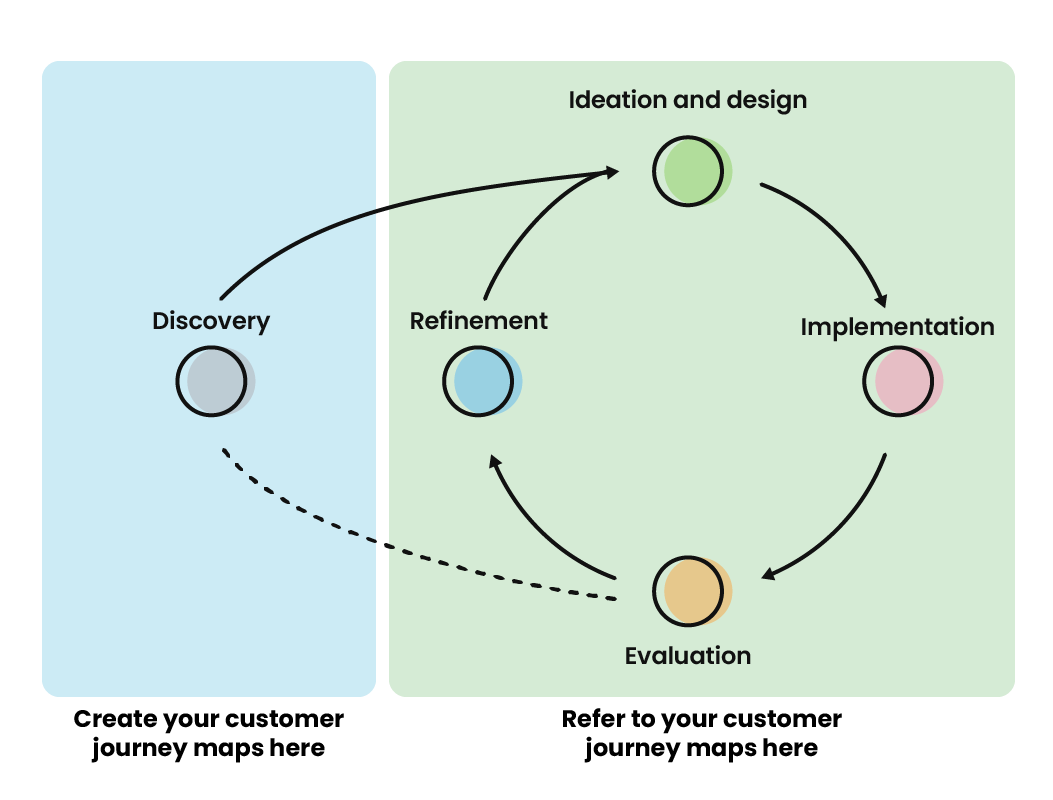
Why you need to put customer experience first
Building a CJM should focus on the customer experience. Understanding the customer journey is vital to understanding what an organisation needs to do to relate to the user.
As marketers, we need to look at the broader picture and discover what the customer wants, what they need, and how we can engage them to continue their journey.
To ensure the exercise provides the best possible value, we recommend using our 10 Steps of Engagement and the COM-B behavioural model (see more information below). We believe this provides a rounded understanding of users' blockers and challenges.
The ten steps of engagement
By following the ten stages of customer experience, we can see what a user goes through on their journey, from being unaware to becoming loyal. These stages form the basis of gaining knowledge during the journey. These ten steps are as follows:
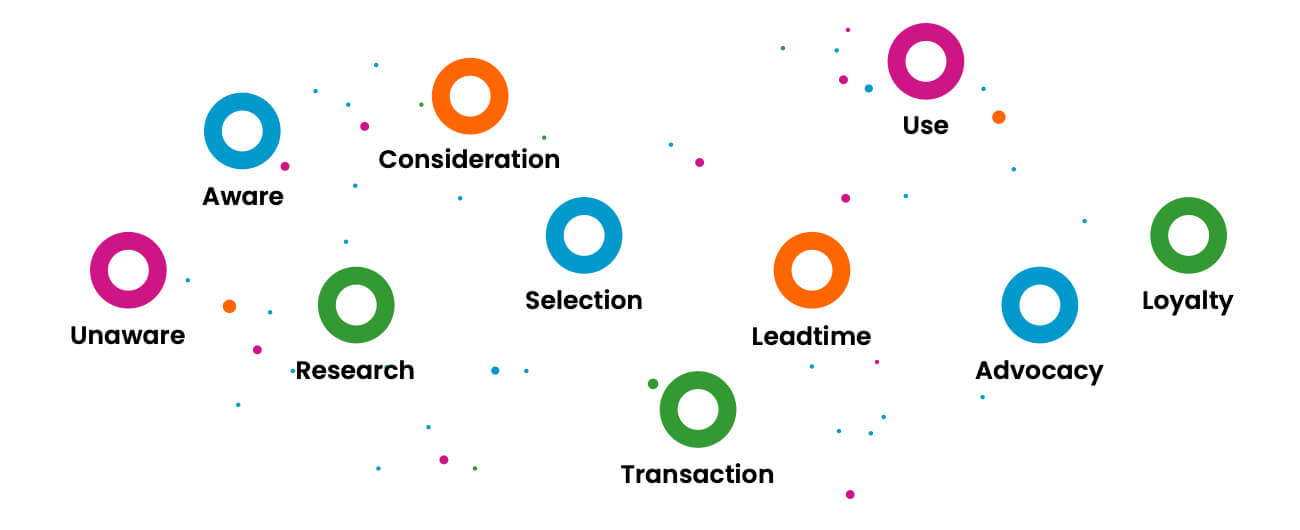
Cross-referencing each of the ten steps of engagement with what the user seeks at a particular point in their journey reveals natural touchpoints. These touchpoints may be missing or even eliminate others already in place.
The following example shows the combination of stages and rows for the customer goals, needs, touchpoints, actions and 'Moments of Truth' (including pain and gain points). Some customer journey maps will also include a row for the organisation's activity and communications.
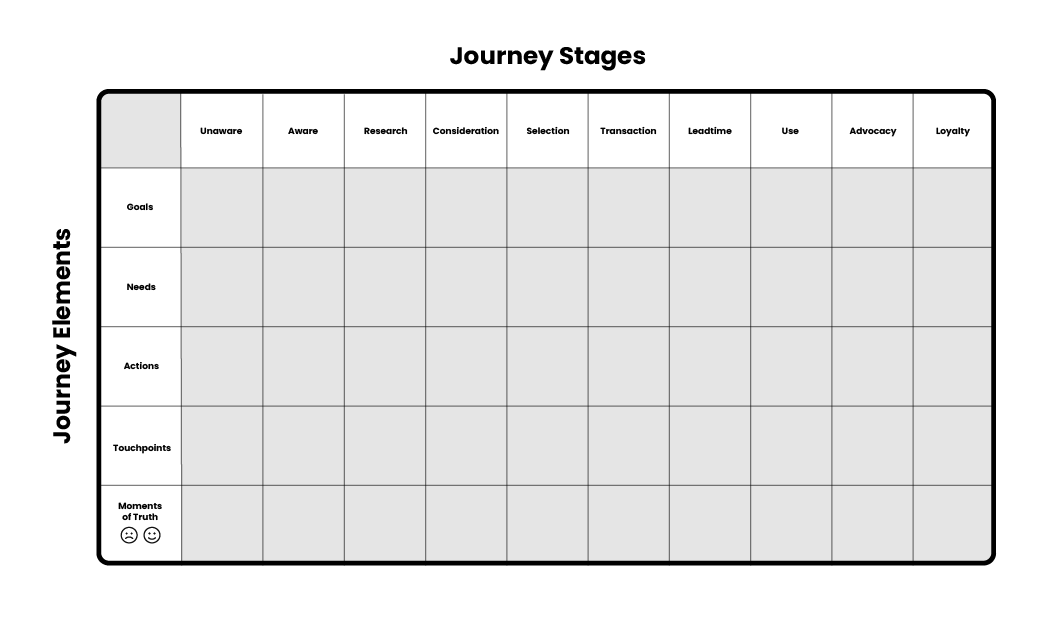
Sector-specific use case examples
The advantage of the customer journey map is that they provide a clear view of the critical focus areas. The following use case examples, for some key sectors, help illustrate what you can do when you look at points on the map where elements and journey stages converge with 'moments of truth'.
Research x Actions
The Research stage is where people make their first and early investigations into something. They will typically have lots of questions and spend their time finding the answers to these. Understanding their actions when researching – for example, talking to friends or using a search engine – allows you to think about whether or not you would be in front of mind when this happens.
Charity example
One example for the charity sector would be if someone experienced a family member being diagnosed with a specific medical condition. A first action might be to use Google to search for information about the condition to gain knowledge. They see many different charities and medical websites in the search results, but not for a UK charity (which is what they expect to see).
Possible fix: Focusing on technical SEO and on-page content improvements for the charity's website to increase search visibility and help to influence its position within the search results.
Selection x Goals
At the Selection stage, the user's goal is to decide on the right product/service they are considering, based on their specific needs and requirements. At this point, users have performed their research and considered several other options.
They are looking at their refined options and will likely move to the transaction phase.
We identify on the completed CJM that there is user churn. The finding allows the team to consider the following:
- Are there too many options and the process confusing?
- Is further guidance needed to prompt users to make a final decision?
- Is there an obvious way for users to compare products in detail and side by side?
- Is delivery information clearly visible?
Education example
In this situation, an example for the education sector would be students looking to choose the right University for their studies (their goal). The map highlights that they cannot easily find the relevant information to help them choose the University over others when considering their final option.
Possible fix: Utilize on-page improvements in content design to give trust and reassurance, and send this information to people via email (having captured their details at a previous stage).
Transaction x Touchpoints
The touchpoint at this moment is the payment screen. The customer has decided and is looking to pay and finalise the transaction. The CJM clearly shows user drop off at this point (and corroborates quantitative data), so why are they disappearing?
eCommerce example
This situation is commonplace within the retail sector, where so much effort has gone into getting people to choose and select a product that the last thing you want to happen is a problem with them purchasing this.
Possible areas of examination include:
- Reviewing the payment process with user testing
- Is it simple to understand with easy payment options?
- Is the process asking a user to go and provide additional information unnecessarily?
- Is the user overloaded with options?
- Is there clear information on stock levels? Can the user expect delivery within 24hrs?
Possible fix: Now there is more evidence of the barriers, optimisers can work on creating a better payment solution and utilising user testing and then A/B testing to test the hypothesis.
Leadtime x Needs
There is very little lead time between transaction and usage in some cases, and it might not seem so important. However, this is often when a person can have some immediate questions about things they want to know.
Understanding these needs at this point in the journey can highlight whether or not you are providing people with the correct information to help reassure them on their decision and support them with getting the most out of their product or service.
Financial services example
In a B2B financial services example, a customer may have secured their business finance and are waiting for the funds to be processed, but then starts to have some questions that give them a bit of doubt about what they have done.
Possible fix: Develop a guide to send to people after their funding is confirmed, which contains the answers to any questions or specific needs.
Journey mapping and creating customer journey maps are hugely beneficial for your business or organisation, as they provide an engaging visual summary for stakeholders. Done right, they can be great for aligning peoples' thinking, validating or disproving assumptions, and sparking inspiration. They will often highlight the critical stages or points where quick improvement can instantly increase customer satisfaction. They are great for all organisations and equally great in the end for your customers, as you weill be improving the experience they have on their journey.
Adam Stafford, Co-founder
Use a behavioural model like COM-B to help understand user behaviour
Many customer journey maps we produce for clients include a 'behavioural' element. This aspect is unique in terms of journey mapping, and we haven't seen it done in other templates or examples before.
What is COM-B?
COM-B is a simple and effective framework for understanding behaviour.
The model has three components:
- Capability
- Opportunity
- Motivation
These make up the 'COM', and the 'B' stands for Behaviour. The model's premise is that it is possible to change a user's behaviour by influencing one or more of a person's capability, opportunity, or motivation.
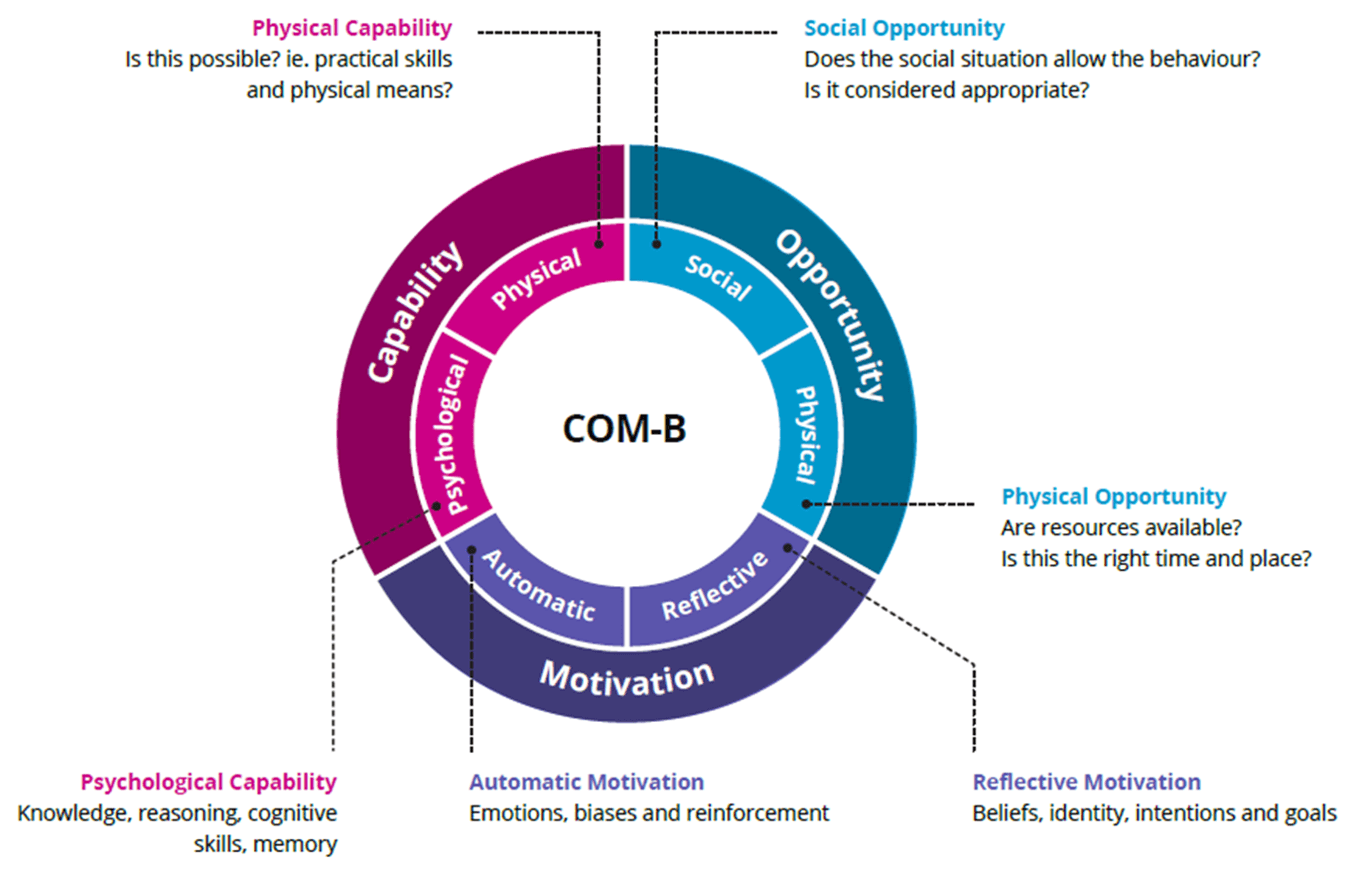
Applying it to journey mapping
By looking at a customer's Capability, Opportunity, and Motivation, it's possible to define the appropriate behaviour and make considerations into influencing them to ease into the next stage of the journey.
When conducting audience research, we find ways to measure the person's COM at each journey stage and indicate these as high, medium or low. Once mapped, these provide a quick, visual way of seeing where there are stages where they are particularly low, and therefore intervention is needed to try and increase them.
For example, we might see that during the Consideration stage of the journey, someone has medium-high Motivation (in this scenario, they want to buy a product) and medium-high Opportunity (they have the money). Still, they have low Capability (they lack the knowledge of the products you and your competitors are offering). Knowing this would lead to the production of some high-quality content, such as a series of how-to guides or explainer videos, then put these in front of the person (based on their noted touchpoints).
As a result, the user has increased knowledge (Capability) and presents the brand as one to consider in this area, building trust with them in the process.
💡 Top Tip!
Gathering information is not as difficult as it seems. Internal stakeholders can provide a wealth of information along with users/visitors.
What’s the logical truth? Researching an audience
Audience research is essential to curating the most accurate customer journey map. Internal company data (qualitative and quantitative) is also vital in understanding the journey in its entirety.
- Gathering internal data:
- Interviews with staff at various positions throughout the company: finance, marketing, admin, and sales all have a part to play.
- Web analytics data, including dropouts, enquiries, transactions, and bouncebacks. This information gives us our unsolicited data.
- Emails, newsletters, and scheduled phone calls.
- Workshops: internal workshops are excellent for getting into the detail with employees. Bringing together the different areas of the company to discuss a primary goal – the customer – always results in excellent and captivating data.
- Gathering external data:
- Client interviews: We recommend interviewing around five or six customers per identified persona to get the best results. Ideally, the interviews consist of six new customers, six existing customers who have purchased in the last 12 months, and six customers who have since moved to a competitor. These would likely consist of 10-minute video interviews and provides solicited data.
- Surveys: Our preference will always be customer interviews for more in-depth analysis; however, surveys can sometimes be helpful as a part of your customer research. It is worth noting that surveys alone would not give enough information to create a map.
💡 Top Tip!
Employees' views can be biased, favouring (correctly or incorrectly) certain parts of a journey or specific touchpoints. The bias can easily cloud judgement when it comes to decision making. Sometimes it is helpful to create an internal map and a separate external map. Comparing the two maps clears the mist, so we can refine and grow with the customer.
What are the benefits of customer journey mapping?
Customer journey mapping paves the way for an organisation to understand user needs. Understanding these needs will contribute to the creation of a more robust solution.
The output provides team members with critical insight into what users want and opens minds to consider new opportunities. It also ensures the entire organisation are on the same 'customer-first' page.
Benefits include:
- Moments of truth – pain and gain:
- GAIN - learn what works well and replicate it: The map should indicate what is working. You can then dissect and replicate.
- PAIN - Understand your sticking points: Research will provide a clear idea of where customers are getting stuck in their journey and where they drop out. Explore these and compare them to areas that are working well and improve them.
- Discover customers' needs and wants at each stage of their journey: We can facilitate them by really understanding customer needs rather than assuming them.
- Customer-centric culture: Developing this shared understanding of the customer journey helps give an organisation shared ownership. Giving this common goal improves relationships between teams and encourages collaboration and empathy in the workplace.
- Easier decision making: A clear understanding of the customer journey simplifies potentially complex and costly decisions by focusing on the critical pain points and excluding personal preference and bias.
- Better employee experiences: Customer understanding leads to autonomy, motivation, and greater focus. You are giving employees the tools and empowering them to make decisions. •
- Keeping control when things feel out of control: Global pandemic? New technologies emerging? Having your journey laid out and your goals clear enables your business to stay in control when things feel unruly out in the wild.
Learn how we helped The Health Foundation
How to make a customer journey map
Okay, now we know why and when we should make a CJM.
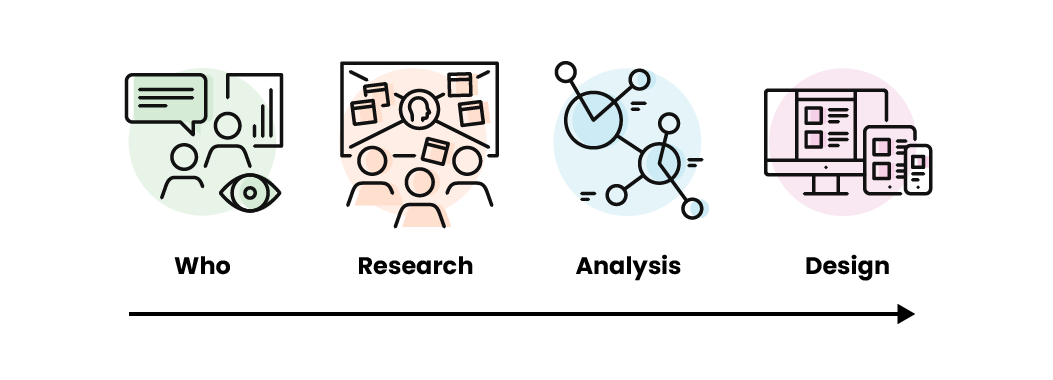
Now's the time to learn how to create one. We simplify the process of making a customer journey map into four steps:
The who
The team
- At this stage, think about the team that needs to be involved internally and part of the mapping process.
- The mapping team needs to be diverse as they will represent your business; we recommend (if possible) including someone from different areas, including marketing and comms, sales and customer service.
- Their feedback and perspectives will be vital to the accuracy of the map, and their input provides a fresh perspective.
Users
To understand the journey, we first need to understand the user. It's now that personas are helpful to the process. Personas are fictional characters based on audience research. For example, they can comprise:
- Big spenders: new customers that you'd like to target
- Regulars: the lifeblood of the business
- The window shopper: Visits frequently but never completes a transaction
We avoid typical 'marketing personas' and a deep dive. We recommend using 'needs based' personas. Using anything else is more complex and accounts for the persona's goals, motivations, and needs, rather than being based on demographics and interests.
Instead of creating or using personas, consider taking a particular audience segment or customer group. If you're thinking of embarking on an audience research project, Examples include:
- Add audience segment
- Add customer group
The research
First things first, confirm a journey that requires mapping. Typically this will be the complete end-to-end journey. However, there may be a need to focus on a specific and shorter journey, for example, how customers renew their services with you? Or how do customers seek Q&A content post-purchase?
Next, decide on the appropriate research methods (which would need to be a qualitative method), such as interviews.
During the research, consider the following when there is an understanding of who is making the journey:
- Why are they making the journey?
- What happens on the journey?
- What is the moment of greatest emotional load?
- What are your customer's attitudes, needs, wants and motivations?
Researching the journey means you will typically take people through each journey stage and ask them questions to understand what's important to them throughout.
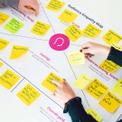
Download our free guide to empathy mapping
Our complimentary tool to journey mapping is a quick and straightforward way of visualising your customer's experiences. It can help define your customer groups, redefine your priorities and helps to construct questions for your audience research.
The analysis
It's now time to start pulling out those key insights and consider where the opportunities are to improve the journey and what solutions are needed to fix the pain points. Brainstorm these ideas, then refine them by deciding what's feasible, measurable, and has the most significant impact.
Start pulling the journey map together using everything you have learned and draft this out, with the content against the appropriate stages and rows.
The design
With insight and understanding, it is time to get the learnings designed into a simple and easy to navigate CJM.
Typically, we design and save maps as a PDF (or similar) so that teams can access them quickly and explore the contents. Often journey maps are printed out in a large format (such as A1) to be displayed in offices, acting as visual reminders and inspiration for people.
💡 Top Tip!
Our clients often put our maps in pride of place, ensuring that customer-centric atmosphere in the workplace.
Is a CJM’s work ever done?
A completed customer journey map will likely have provided many ideas. Many of the current touchpoints will probably need amending, and others will need an introduction. Removing those that have no effect should not be overlooked. To progress, less is sometimes more.
We believe that CJMs should only be effective but designed to be understandable for your entire company. But that is not the end of the story. We always recommend having the CJMs easily accessible to be regularly updated as an organisation grows and the journey adapts. Review them often, use Post-It Notes and involve colleagues. Keep an organisation fuelled by its users.
A CJM will become an irreplaceable tool for an organisation. Done right, they are effective as an ongoing device for constant improvement, keeping your customers at the heart of the organisation and empowering your employees.
How often should journey mapping occur?
Don't view a journey map exercise as a one-off. While it provides excellent value and inspiration once created, updating a journey map should happen on an ongoing basis to ensure it reflects your customers' current views, needs, and experiences.
There is no hard-and-fast rule on how often you should update them. Doing so depends upon an organisation (and its own needs). However, they might be updated when there is some significant change to your product or service. Updates might include a new product launch, a complete redesign of your website or a change in how a service is delivered (i.e., by switching offline touchpoints to being purely online).
It makes sense to update them following some new research, a large-scale customer survey or a quantitative review of the end-to-end digital journey.
Regardless of how often they are updated, we recommend implementing a process for reviewing them regularly, whether that's quarterly, every six months or annually.
How often they are reviewed and updated might also be determined by how strategic (broader, big picture view) or tactical (focused on specific areas/channels) they are.
Measuring the effect of customer journey mapping work
We always recommend having a measurement plan in place. Without this, it will be harder for an organisation to measure the success of the work carried out because of identifying things to fix from the CJM.
A measurement plan in this situation is likely to include:
- The objectives of what you want to achieve - for example, 'improving the level of information provided to customers to help them choose the right product' or 'providing better post-transaction support to engage users for repeat orders'.
- KPIs – what are the broad key performance indicators that help show if you are achieving the objectives? For example, website traffic or conversions.
- Metrics – what are the individual things you can measure under each KPI to show progress? For example, user sessions, video plays or leads by channel.
With thorough measurement planning, it's possible to relay the issues, subsequent fixes, and project successes of the exercise findings to senior stakeholders, highlighting the work's impact. Learn more about measurement planning.
💡 Top Tip!
Ensure your web analytics of choice is tracking correctly and any other tracking required for associated digital activity (email/CRM, social). Then decide how to measure the impact of any changes made to the overall customer experience.
Now it's time to practice your new skills
We hope this guide has proved helpful in understanding the benefits of creating customer journey maps and the end-to-end process. If this is an area where you are looking for help and support, please do not hesitate to contact us.
Do you have a challenge we can help with?
Let's have a chat about it! Call us on 01903 337 580





